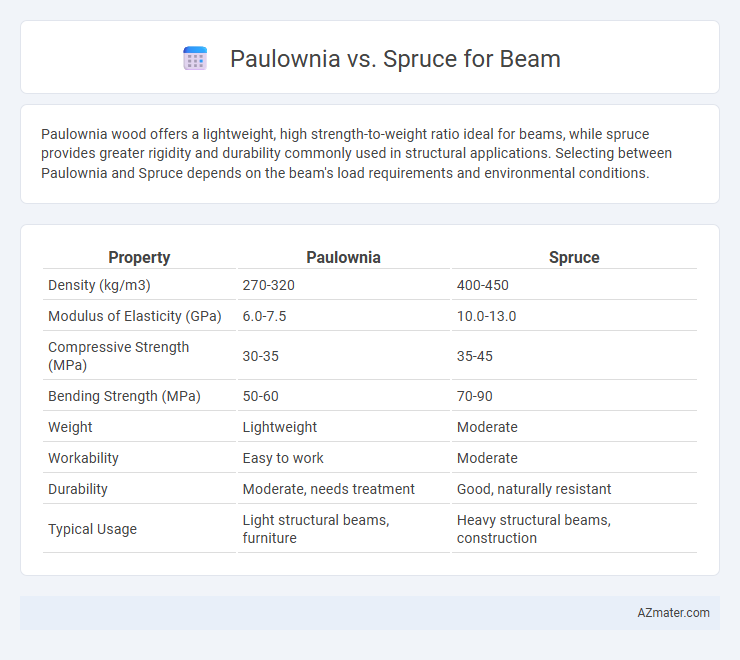Paulownia wood offers a lightweight, high strength-to-weight ratio ideal for beams, while spruce provides greater rigidity and durability commonly used in structural applications. Selecting between Paulownia and Spruce depends on the beam's load requirements and environmental conditions.
Table of Comparison
| Property | Paulownia | Spruce |
|---|---|---|
| Density (kg/m3) | 270-320 | 400-450 |
| Modulus of Elasticity (GPa) | 6.0-7.5 | 10.0-13.0 |
| Compressive Strength (MPa) | 30-35 | 35-45 |
| Bending Strength (MPa) | 50-60 | 70-90 |
| Weight | Lightweight | Moderate |
| Workability | Easy to work | Moderate |
| Durability | Moderate, needs treatment | Good, naturally resistant |
| Typical Usage | Light structural beams, furniture | Heavy structural beams, construction |
Introduction to Paulownia and Spruce as Beam Materials
Paulownia and spruce are widely used timber species for beam construction, valued for their respective strength-to-weight ratios and workability. Paulownia, known for its rapid growth and lightweight characteristics, offers excellent stability and resistance to warping, making it ideal for structural beams in lightweight applications. Spruce, a traditional softwood, is favored for its consistent strength, stiffness, and availability, often used in heavy-load bearing beams in construction and timber framing.
Density and Weight Comparison
Paulownia wood has a significantly lower density, approximately 260 kg/m3, compared to spruce, which has a density around 400-450 kg/m3, making Paulownia much lighter and easier to handle for beam applications. This low density results in beams that are less heavy, reducing overall structural weight without compromising basic strength, ideal for lightweight construction. Spruce beams, denser and heavier, offer higher strength and stiffness, suitable for load-bearing structures where weight is less of a concern.
Strength and Load-Bearing Capacity
Paulownia wood is lightweight but offers lower tensile and compressive strength compared to spruce, making spruce preferable for high load-bearing beams in construction. Spruce has a higher modulus of elasticity and superior density, resulting in better resistance to bending and greater overall structural stability. For applications demanding maximum strength and long-term durability under heavy loads, spruce beams are generally the optimal choice.
Durability and Lifespan
Paulownia wood offers a lightweight option with moderate durability but generally has a shorter lifespan under heavy structural loads compared to spruce. Spruce beams are favored for their superior strength, durability, and resistance to wear, making them ideal for long-term structural applications. While Paulownia excels in ease of handling and resistance to warping, spruce provides enhanced longevity and consistent performance in beam construction.
Resistance to Environmental Factors
Paulownia wood exhibits excellent resistance to moisture and decay, making it highly suitable for beams exposed to humid or variable weather conditions. Spruce, while strong and lightweight, is more prone to fungal attack and requires protective treatments to maintain durability in damp environments. The inherent resistance of Paulownia to environmental factors often results in longer-lasting structural performance with less maintenance compared to Spruce.
Workability and Ease of Fabrication
Paulownia offers superior workability compared to spruce due to its lighter density and softer grain, making it easier to cut, shape, and sand with common woodworking tools. Spruce, while stronger in structural applications, tends to be harder and more prone to splintering, requiring more precision and care during fabrication. For beams where ease of fabrication and quick machining are priorities, Paulownia provides a more user-friendly option without significantly compromising structural integrity.
Cost and Availability
Paulownia wood offers a cost-effective alternative to spruce for beams, with lower material prices due to its rapid growth and sustainable cultivation. While spruce remains widely available globally, Paulownia's increasing production in Asia and parts of Europe improves its accessibility for construction projects. Builders often choose Paulownia for budget-friendly applications, though spruce may still dominate markets where traditional sourcing and consistent quality are prioritized.
Sustainability and Eco-Friendliness
Paulownia wood offers significant sustainability advantages over spruce due to its rapid growth rate, reaching maturity in as little as 10 years compared to spruce's 30-50 years, enabling faster carbon sequestration and renewable timber supply. Paulownia's lightweight and high strength-to-weight ratio reduce transportation emissions and structural material usage, enhancing eco-friendliness in beam applications. In contrast, spruce, while widely used and strong, relies on slower forest regeneration cycles, increasing its environmental footprint relative to fast-growing Paulownia.
Applications in Construction and Architecture
Paulownia beams offer superior lightweight properties and excellent thermal insulation, making them ideal for sustainable construction and eco-friendly architectural designs. Spruce beams provide greater structural strength and stiffness, commonly used in load-bearing applications such as frameworks and roof trusses. Both materials serve distinct roles in construction, with Paulownia favored for its workability and moisture resistance, while Spruce is preferred for its durability and cost-effectiveness in traditional building projects.
Conclusion: Choosing the Best Wood for Beams
Paulownia offers a lightweight structure with high strength-to-weight ratio, making it ideal for beams where ease of handling and reduced load are critical. Spruce provides superior stiffness and durability, often preferred for heavy-load bearing beams in construction due to its consistent strength and resistance to bending. For optimal beam performance, select Paulownia for lightweight applications requiring rapid installation, while Spruce is the best choice for structural integrity in demanding load conditions.

Infographic: Paulownia vs Spruce for Beam
 azmater.com
azmater.com